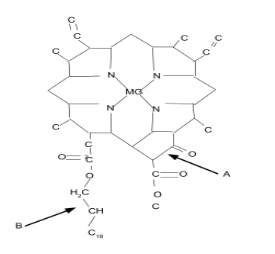
What is the structure of chlorophyll?
Answer
565.2k+ views
Hint: Chlorophyll is a green coloured pigment found in leaves which helps in photosynthesis. Chlorophyll a and b are two types of chlorophyll. The structure has a porphyrin ring connected to a phytol ring. Different alterations occur in the structure due to the presence of side groups.
Complete answer:
Photosynthesis is the process in which light energy is transformed to chemical energy. Chlorophyll is the essential pigment which helps in photosynthesis. It is present in green plants, cyanobacteria etc. It achieves the energy from sunlight and by this energy carbon dioxide is converted to carbohydrates. Chlorophyll is enclosed in the thylakoid membrane of chloroplast. Chlorophyll is the derivative of porphyrin with magnesium at the core. Formula of chlorophyll is ${C_{55}}{H_{72}}{O_6}{N_4}Mg$. In 1817, Joseph Bienaime and Caventou and Pierre Joseph identified chlorophyll.

The light consumed by chlorophyll thrills the electrons present in the ring. The difference in the structure of chlorophyll a and b is: Chlorophyll a $R \to C{H_3}$ Chlorophyll b $R \to CHO$ Both of them are good photoreceptors they have alternating single or double bonds and delocalised polyenes which helps in the absorption of energy from sunlight.Chlorophyll a deliver the absorption peak at 430 nm to 663nm whereas chlorophyll b at 453 to 642 nm. The reaction center for chlorophyll consumes light energy to pass it to different photosystems.
Note: Green plants contain chlorophyll a and yellow green plants have chlorophyll b which is a catalyst for photosynthesis. Commercial produced chloroplast are dark green solutions in oil, water or ethanol. It is also used for bleaching oils, soaps, dyeing etc.
Complete answer:
Photosynthesis is the process in which light energy is transformed to chemical energy. Chlorophyll is the essential pigment which helps in photosynthesis. It is present in green plants, cyanobacteria etc. It achieves the energy from sunlight and by this energy carbon dioxide is converted to carbohydrates. Chlorophyll is enclosed in the thylakoid membrane of chloroplast. Chlorophyll is the derivative of porphyrin with magnesium at the core. Formula of chlorophyll is ${C_{55}}{H_{72}}{O_6}{N_4}Mg$. In 1817, Joseph Bienaime and Caventou and Pierre Joseph identified chlorophyll.

The light consumed by chlorophyll thrills the electrons present in the ring. The difference in the structure of chlorophyll a and b is: Chlorophyll a $R \to C{H_3}$ Chlorophyll b $R \to CHO$ Both of them are good photoreceptors they have alternating single or double bonds and delocalised polyenes which helps in the absorption of energy from sunlight.Chlorophyll a deliver the absorption peak at 430 nm to 663nm whereas chlorophyll b at 453 to 642 nm. The reaction center for chlorophyll consumes light energy to pass it to different photosystems.
Note: Green plants contain chlorophyll a and yellow green plants have chlorophyll b which is a catalyst for photosynthesis. Commercial produced chloroplast are dark green solutions in oil, water or ethanol. It is also used for bleaching oils, soaps, dyeing etc.
Recently Updated Pages
Why are manures considered better than fertilizers class 11 biology CBSE

Find the coordinates of the midpoint of the line segment class 11 maths CBSE

Distinguish between static friction limiting friction class 11 physics CBSE

The Chairman of the constituent Assembly was A Jawaharlal class 11 social science CBSE

The first National Commission on Labour NCL submitted class 11 social science CBSE

Number of all subshell of n + l 7 is A 4 B 5 C 6 D class 11 chemistry CBSE

Trending doubts
Differentiate between an exothermic and an endothermic class 11 chemistry CBSE

10 examples of friction in our daily life

One Metric ton is equal to kg A 10000 B 1000 C 100 class 11 physics CBSE

Difference Between Prokaryotic Cells and Eukaryotic Cells

State the laws of reflection of light

Explain zero factorial class 11 maths CBSE




